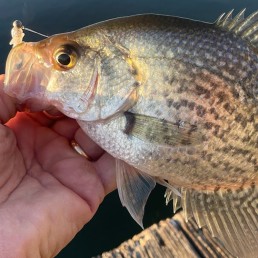Finding Summertime Crappies
SHARE THIS POST
The best advice about crappie fishing involves the words “most of the time,” “generally speaking” and sometimes “never seen this fail until today.” In other words, my crappie fishing advice is not 100 percent accurate. For instance, “Fish always bite two days before a cold front” is sound instruction. It works well…unless some outside force interferes. Sometimes, you just can’t find the !%%$## fish.
If you’re fishing from the bank on a pond ringed with moss, I would use the old cane pole trick. (The heavy moss would make a rod and reel retrieve impossible.) I would rig the pole with 15-pound mono and a 6-foot, 4-pound-test leader. The total length of the line must be the same of as the length of the pole. This is vital! Because, when a fish is hooked, you can lift it straight up over the moss, into your hands.
I use two jigs per rod, which is legal in Iowa. Slide a keeper up about 3 feet onto your line. Follow the keeper with a small, red bead. Tie a foot-long length of 4-pound-test mono to one end to the line directly under the bead, and the other end to your lure of choice. A foot or so directly below the first rig, repeat. Then tie a 1/4-ounce bell sinker to the end of your line.
This is a mid-deep rig that I use out past the emergent moss. It works on crappies and big bluegills. Big bluegills prefer minnows; so do crappies. Use a stationary live bait; a hooked minnow exudes a scent that attracts fish. This setup allows you to adjust the depth being fished by simply sliding the drop line up or down the main line.
Boatless anglers can sometimes walk the top of the dam if the top is close to the water. For example, with a south breeze, the dam at the north end of Lake Miami is perfect.
When the moss is heavy, the only bait I use is a 1-1/8-inch Johnson Silver Minnow. This lure is virtually snagless and has been catching fish for over 100 years! The hook point must be needle-sharp and requires resharpening during the day. Just mosey down the dam, casting to likely spots. Big fish will be in 6 to 8 feet of water, scattered in loose pods.
Instead of a stringer or bulky 5-gallon bucket, I use a wet gunny sack and a length of rope. I put my caught fish in the gunny sack, tie it at the sack opening, and, after securing the loose end of the rope, toss it back in the water. I have seen Canadian guides use the gunny sack trick instead of a stringer.
On a sunny afternoon, fishing a sunken brush pile for crappies from a boat, use a slip-bobber. I prefer a 1/64-ounce, black, Lindy Little Nipper sweetened with a bit of nightcrawler. I slide my bobber down until the floating lure rides about 6 inches above the snags. Retrieve slowly. Remember: Fish do not like bright light.
Are you enjoying this post?
You can be among the first to get the latest info on where to go, what to use and how to use it!
If fishing standing timber on a bright day, crappies will be deep to avoid bright light. I might cast my tooth-scarred, tiny Silver Minnow at nearby, standing dead trees. As the lure bounces off a tree and falls into water, watch the line play out as the lure wiggles to the bottom. Retrieve it with short jerks that rattle the snags and kick up the mud. If something hits my spoon and drops it, and nothing happens after two or three more casts, I hook a 1-inch pork rind strip on my spoon and try again.
A good example of fish/light reaction occurs at Lake Miami in southern Iowa. When the afternoon sun slips behind the wooded hills bordering the west side of Miami, the western third of the lake becomes shady. Crappies move up in the water column to feed. The fish loosely concentrate in an area out from the two coves on Miami’s west bank, holding in about 6 feet of water.
My buddies and I fish this area from a jon boat with an electric motor. We fish 4-pound mono and a 1/64-ounce, black Lindy jig attached to a chartreuse, plastic tube jig. My buddies fish a heavier jig than mine. Our results are about the same.
During bright sunshine, fish anywhere there are stationary shadows on the water. Docks are great! Fish as close to them as you dare. If the is enough space between the water’s surface and underside of the dock, skip your bait into that space and hold on!
Always fish the shadowy side of a tree. During your retrieve, bump your lure against the tree. Fish fallen timber. Fish into the wind. Cloudy days are great. Fish periods of low light, if possible.
You’ll find plenty of helpful summer fishing tips in the summer issues of MidWest Outdoors. Subscribe on our website.
MWO
SHARE THIS POST
You may also like...
Nothing found.
Did you enjoy this post?
You can be among the first to get the latest info on where to go, what to use and how to use it!
Tony Humeston
Tony Humeston grew up running a trap line, and hunting and fishing. After a successful business career, he now devotes his time to writing, hunting and fishing. He is an avid fly-fisherman and addicted bird hunter; he loves labs, and is a licensed judge with the North American Hunting Retriever Association.
